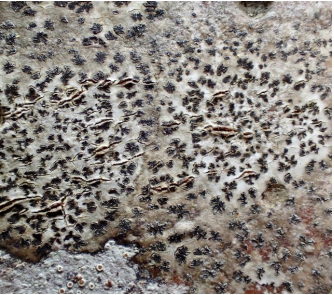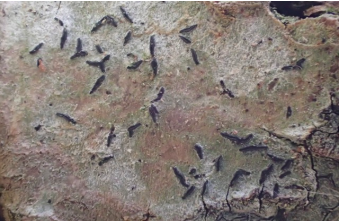Lichens on Forres Friends Land
- Heather Paul
- Aug 8, 2022
- 5 min read
Updated: Aug 7
By Heather Paul
Lichens are a partnership between at least two organisms - usually a fungus and an alga which grow together. This is called symbiosis.
The fungus provides a protective home for the alga - protecting the alga from drying winds, strong sunlight and excessive wetting. The algae photosynthesise in sunlight and make food for both of them.
Lichens are seen as “indicators”. Some species need clean air, whilst others thrive where there is pollution.

The photo shows a grey-green beard lichen (Usnea). This is one of the lichens which grow where the air is “cleaner”. In the Forres Friends of Woods and Fields (FFWF) wood it is found frequently, hanging from twigs in little bunches. It contains usnic acid, which has been used to make antibiotics, deodorants, toothpaste, and dye for clothes. Birds use it to make nests.

This photo shows Xanthoria parietina. Xanthos is Greek for golden-yellow, and this lichen contains parietin, which is a yellow pigment. It acts as a “sun-screen”, protecting the lichen from damaging ultraviolet.. This lichen grows well in more polluted areas and is often found on bird perches as their droppings contain ammonia, which benefits this lichen. It is also frequently found on Elder.

Lichens grow in many different places in the FFWF wood, such as on the dry or wet side of trees, high up in the canopy or lower down near the base of the tree. Some grow on trunks of trees, others on tiny twigs. and some grow on old tree stumps. Most lichens prefer to be in the light rather than in dark places. The photo below shows a twig with a mosaic of lichens completely covering the bark.
Some lichens grow in lines on smooth bark or look like little stars.

This is Evernia prunastri – called“oak moss” although it is a lichen and not a moss. It has been used for many purposes – eg as a fixative for perfume, to make dyes, and to make a hair powder by grinding it up with rose petals to whiten wigs. It contains an acid which has been used to make an antibiotic but also has been known to produce an allergy in woodcutters. Birds use it to make and camouflage their nests and tiny creatures take shelter in it.

Lichens often colonise the lighter topside of branches. Some lichens grow on smooth bark eg beech , others prefer rough bark eg oak. This is a picture of Chrysothrix candelaris or “gold-dust lichen” growing on an oak in the woods and the next photo is of a very tiny black “pin-head” lichen growing with it in the cracks.

Chrysothrix candelaris or “gold-dust lichen”
The land at Forres Friends of Woods and Fields mostly supports lichens growing on the trees and fenceposts. One lichen has been found growing on the ground in the fields but lichens are mostly unable to grow where there is higher vegetation eg long grass. Lichens also grow on rock but this site is not rocky.
Trees have different bark acidity and their bark may be more or less water-absorbent. This can affect which lichens grow on them.
“pine and larch - most acid(down to pH3.2)
birch, oak (pH3.8-5.8)
rowan, alder, beech, lime,ash (pH5.2-6.6)
elder, sycamore, field maple, apple, poplar, willow, elm - least acid (pH4.7- 7.1) Bark pH is affected by pollution and may vary at different heights on the tree” https://britishlichensociety.org.uk/learning/lichen-ecology
Lichens can be seen all year. Winter is a great time to look at lichens as they are easier to see when there are no leaves on the trees and often there are broken branches lying on the ground after wind. As they are so tiny a x10 hand lens is useful to see their beautiful and intricate structures more clearly.
List of lichens and lichenicolous fungus recorded - Forres Friends of Woods and Fields
81 species are listed. Some are marked LF . These are lichenicolous fungus which are fungus that grow on lichens.These are usually very small and sometimes they look like little black dots. Thanks to Brian Coppins who helped with identification.
19-12-14
Pyrrhospora quernea on oak
Buellia schaereri on oak growing amongst Chrysothrix candelaris
2-9-16
Chaenotheca trichialis growing with Chrysothrix candelaris A pinhead lichen
17-11-18
Platismatia glauca
10-3-19
Calicium viride NJ042580 on Oak A pinhead lichen
Chrysothrix candelaris on Oak “Gold dust lichen”
Phlyctis argena
24-4-19
Evernia prunastri NJ044582 widespread “Oak moss”
Unguiculariopsis lettaui (LF) growing on Evernia prunastri
28-10-19
Pertusaria leioplaca
21-03-20
Melanohalea exasperata NJ042580 on Oak
21-5-20
All on fallen Ash NJ042582 Most of these also grow on other trees eg on Oak
Xanthoria parietina
Ramalina farinacea
Ramalina fastigiata
Ramalina fraxinea
Lecidella elaeochroma
Melanelixia subaurifera
Parmelia sulcata
Marchandiomyces coarallinus (LF) growing on Parmelia sulcata and on Lecanora chlarotera s lat
Lecanora carpinea
Physconia distorta
Physcia stellaris
Physcia adscendens
Rinodina sophodes
Pseudevernia furfuracea var ceratea
Usnea hirta “Beard lichen”
Usnea subfloridana “Beard lichen”
Hypogymnia physodes “ Heather rags”” ( widespread on trees locally and on heather)
Phaeophyscia orbicularis
Lichenochora aipoliae (LF) growing on Physcia stellaris
Usnea wasmuthii “Beard lichen”
Arthonia radiata “Asterisk lichen”
Heterocephalacria physciacearum (LF) growing on Physcia sp.
10-2-20
Kalchbrenneriella cyanescens (LF) on Usnea sp. on alder NJ043582
15-1-21
Cladonia macilenta on rotting stump
23-1-21
Tuckermanopsis chlorophylla on Beech
Calicium salicinum on Oak lignum A pinhead lichen
Unguiculariopsis thallophila (LF) growing on Lecanora chlarotera s lat
26-1-21
Bryoria subcana on Oak NJ042580 and on Beech
Lichenoconium erodens (LF) growing on Bryoria subcana, Parmelia sulcata and on Evernia prunastri
Pertusaria pertusa on Beech “Pepperpots”
Opegrapha atra A “script lichen “ looking like writing
Melanelixia glabratula on Beech
27-1-21
Pertusaria amara on Oak
Cliostomum griffithii on Oak
Lecanora expallens
29-1-21
Briancoppinsia cytospora (LF)on moribund Hypogymnia on Oak 2-2-21 Hypocenomycis scalaris on Larch NJ 042579
Clypeococcum hypocenomycis (LF) on Hypocenomyce scalaris Ochrolechia androgyna on Beech
Lecanora sarcopidoides on Larch NJ042579 New to Vice County of Moray Nationally rare
3-2-21
Anisomeridium polypori on Oak trunk NJ042580
5-2-21
Lepraria incana
15-2-21
Pseudoschismatomma rufescens on Oak NJ042580
Opegrapha varia
Parmeliopsis hyperopta on lignum NJ042580
Calicium glaucellum NJ042580 (pinhead)
17-2-21
Tremella hypogymniae (LF) on Hypogymnia physodes on Beech NJ042580
24-2-21
Xanthoria polycarpa on conifer
Lichenoconium xanthoriae (LF) growing on Xanthoria polycarpa Lecanora confusa on dead twig NJ043581
Lecanora symmicta “ “
Amandinea punctata “ “
Porina aenea “ “
Opegrapha niveoatra “ “
27-2-21
Telogalla olivieri (LF) growing on Xanthoria parietina
Lichenochora galligena (LF) on Physciatenella/adcendens NJ046580 on Beech. New to Vice County of Moray
Spirographa tricupulata (LF) on Physcia stellaris NJ046580. New to the British Isles. Previously only recorded in Austria
Lecania naegelii
10-3-21
Caloplaca cerina on Elder NJ043580
Peltigera didactyla on soil NJ043581
20-3-21
Everniicola flexispora (LF) on Evernia prunastri NJ043580
7-4-21
Candelariella vitellina on top of fence post NJ044581
Opegrapha vermicellifera on dead Elm NJ043582
Bacidia rubella on Ash NJ047579
Vouauxiella lichenicola (LF) growing on a Lecanora species
Xenonectriella physciacearum (LF) growing on Physcia aipolia/stellaris NJ047579
10-2-22
Pronectria anisospora (LF) growing on Hypogymnia physodes on hawthorn
Abrothallus bertianus (LF) growing on Melanohalea exasperata on fallen twig
Heather Paul, April 2022






Comments